

Monitoring Lung Disease using Electronic Stethoscope Arrays Kyle Mulligan, Andy Adler, Rafik Goubran Department of Systems and Computer Engineering Carleton University CMBEC32 Calgary, AB 23 May 2009
Agenda � Background � Motivation � Solution � Medical Instrument Development � Data Processing Algorithm � Phantom Models � Experimental Results � Conclusions
Background Auscultation Adaptive Filtering Non-Linearities Stethoscope White Respiratory Gaussian Disease Noise
What is stethoscope auscultation?
Respiratory Diseases � This project focuses on airway obstructions caused by excess mucus in related diseases including: • Pneumonia • Bronchitis • Emphysema • Asthma
White Gaussian Noise � White Gaussian Noise is a randomly generated signal across a range of frequencies � Useful for system identification due to wide frequency band and linear phase Transfer Function Input Signal Output Signal Frequency Frequency Magnitude (V) 1 Value (500 Hz) 1 Value (500 Hz) Range (0 – 4 kHz) Range (0 – 4kHz) Frequency (Hz)
Adaptive Filtering � Easily determine behaviour of unknown linear systems � Implemented using a Finite Impulse Response filter with a set number of updatable coefficients � Coefficients are updated with each iteration of the algorithm by the equation: d[n] e[n] Mother + Fetal ECG Input Signal Fetal ECG y[n] Adaptive Reference Signal Mother ECG Filter
Impulse Response and Transfer Function � The impulse response is derived from the adaptive filter coefficients upon convergence of the algorithm � The coefficient that has the highest value designates the dominant transmission path of the input signal through the system to the measurement point � The transfer function of a system dictates the system’s behavior to any input signal. Obtained using the equation for the impulse response and sweeping over a range of frequencies (typically 0 – � rads/sample) -3 NLMS Filter Coefficients x 10 5 0 4 Magnitude (dB) 3 -50 2 1 |Coefficient| -100 0 0.1 0.2 0.3 0.4 0.5 0.6 0.7 0.8 0.9 1 0 Normalized Frequency ( ×π rad/sample) 5 x 10 -1 1 Phase (degrees) -2 0 -3 -1 -4 -5 -2 0 500 1000 1500 2000 2500 3000 3500 4000 4500 5000 0 0.1 0.2 0.3 0.4 0.5 0.6 0.7 0.8 0.9 1 Coefficient Normalized Frequency ( ×π rad/sample)
Non-Linearities � A non-linear system is that in which its output is not linearly proportional to the input into the system and thus cannot be described by a simple linear equation � The performance of the algorithm depends on what excites the non-linear components of the system � Caused by loudspeaker
Motivation � Improve patient health by reducing ventilator induced lung injury (VILI) and help in the selection of optimal ventilation parameters � The instruments currently available either don't provide regional information (ie SpO2), or temporal information (ie X-ray CT) � Breath Variability between auscultation points � Auditory training variability between physicians
Solution � Take advantage of signals generated from electronic stethoscopes and adaptive filtering techniques to develop an instrument capable of measuring changes in the distribution of lung fluid and tissue densities within the respiratory system � Use an array of stethoscopes and a low frequency input sound projected into the mouth
Instrument Development � Basic Structure
Instrument Development cnt. � Actual Components with Participant Sound Generator Pre-Amplifier Computer Stethoscope Array and Harness Attached to a Participant
Data Processing Algorithm � Used adaptive filtering setup that employed the Normalized Least Mean Squared (NLMS) algorithm � Number of Coefficients = 1500 � Step Size µ = 0.296 � Input Signal = Reference Signal = WGN (0 – 4 KHz) d[n] e[n] Unknown Input Signal Chest Linear System y[n] Adaptive Filter
Instrument Calibration � Sound propagation delay must not take into account the delay of the instruments emitting and acquisition devices.
Phantom Models � Verify algorithm functionality using known predictable sound propagation models � Add complexity in an effort to simulate actual human chests
Open Air Column Model � Hollow cylindrical tube with each stethoscope attached to the surface � Use v = d/t, NLMS, Cross-Correlation to verify propagation delay of pulsed WGN input
Plastic Bucket Model
Chest Phantom Model � Modified Plastic Bucket Model to provide a better phantom-stethoscope head interface. Syringe and Speaker Attachment / Y-Pipe Clear Tube Foam Cylinder Stethoscope Array and Harness
Chest Phantom Experiment � Inject sound into model � Increase the volume of water inside the inner tube by 5cc until saturation � Run NLMS Algorithm for 195 trials and plot average impulse response and retrieved delay
Delay Estimation and Volume Location using the Impulse Response No Water in FOV Water in FOV Delay vs. Volume for Channel 2 Delay vs. Volume for Channel 3 100 130 98 125 96 94 120 Delay (Samples) Delay (Samples) 92 90 115 88 110 86 84 105 82 80 100 0 5 10 15 20 25 30 0 5 10 15 20 25 30 Volume (cc) Volume (cc)
Conclusion and Future Work � A novel instrument has been developed to measure changes in propagation delay as the density of water increases within a chest phantom model � The instrument is capable of monitoring changes in the location of fluid within the chest phantom model � Preliminary human trials correlate nicely with chest phantom model results
Recommend
More recommend